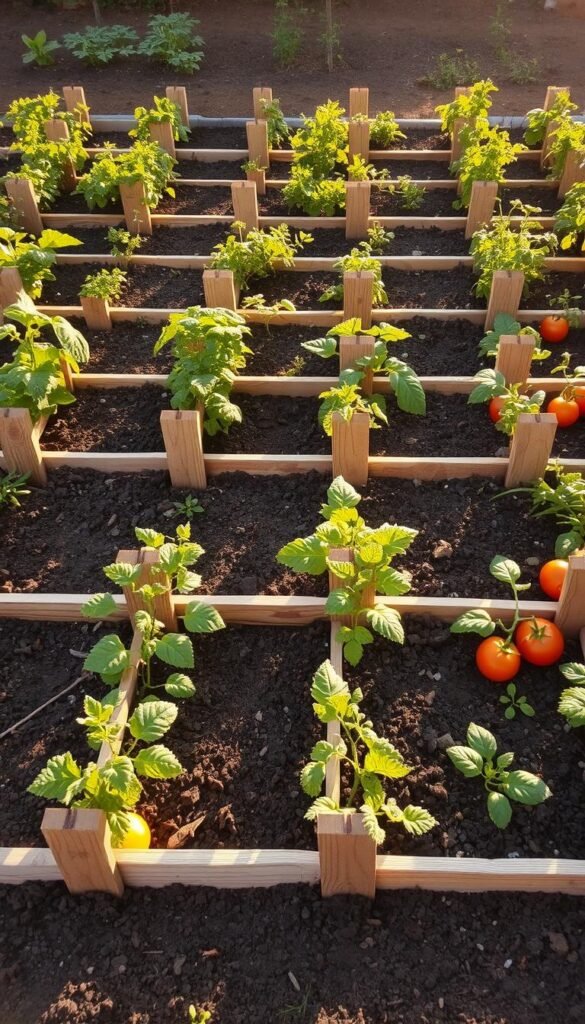Imagine harvesting juicy tomatoes, crisp lettuce, and colorful peppers from a space smaller than your dining table. That’s the magic of grid-based gardening, a space-saving method created by Mel Bartholomew in the 1970s. Instead of endless rows, plants grow in organized 4×4-foot blocks tailored to their needs.
This approach isn’t just neat—it’s efficient. You’ll use 20% less space and 90% less water than traditional gardens while enjoying five times the yield. Beginners love how it removes guesswork: each square has clear planting rules, whether you’re growing carrots or zucchini.
What makes it truly special? You’ll spend weekends relaxing instead of weeding. The system requires 98% less maintenance than row gardening, thanks to strategic layouts that suppress weeds naturally. Raised beds filled with nutrient-rich soil mixes keep plants thriving without constant attention.
Ready to transform your backyard? Our guide to how to plan a square foot garden for maximum shows you where to start. You’ll learn to build productive growing zones that fit any lifestyle—no farming experience required.
Understanding Square Foot Gardening
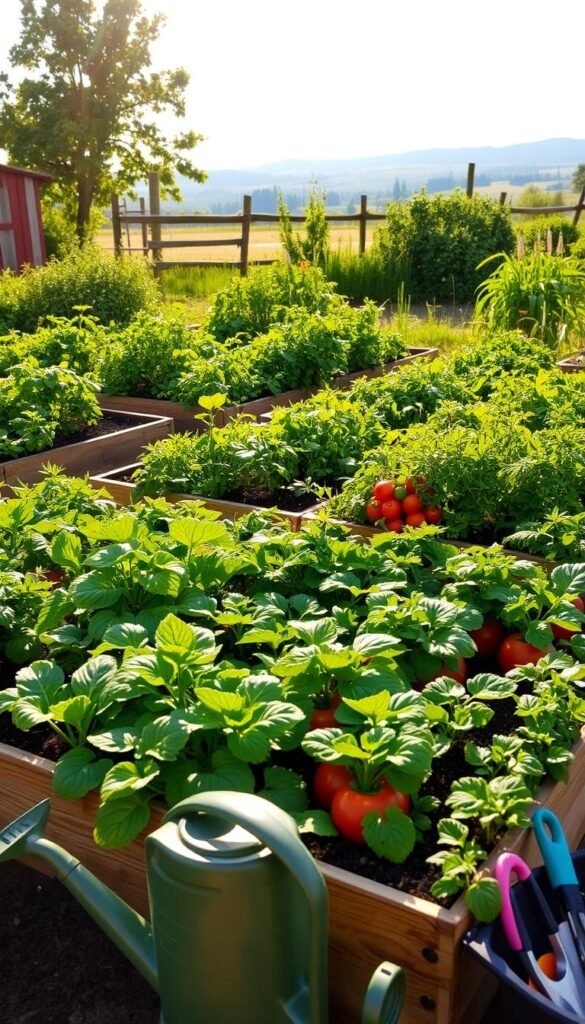
Transforming tiny areas into food factories isn’t magic—it’s smart garden design. This gardening method thrives where space is limited, turning patios, balconies, and narrow yards into productive green zones. Let’s explore why millions choose this system for urban and suburban growing.
Why Compact Spaces Bloom Bigger
In cities where concrete dominates, square foot gardening lets you grow salad greens in 1×1-foot sections and tomatoes vertically. A single 4×4-foot box yields 32 heads of lettuce every three weeks—enough to share with neighbors. Schools use these manageable plots to teach kids biology, while families enjoy fresh ingredients steps from their kitchens.
From Engineering to Earth Science
Retired engineer Mel Bartholomew redesigned traditional gardens after noticing wasted space between rows. His “no weeds, no work” system uses precise spacing to crowd out unwanted plants naturally. Unlike conventional plots, you’ll never need a rototiller or shovel—just your hands and occasional seasonal care.
The secret lies in the soil mix and grid layout. By combining equal parts compost, vermiculite, and peat moss, you create a fluffy bed that retains moisture and nutrients. This blend lets roots spread easily without compacting, meaning more growth in less space. It’s why rooftop farms and community gardens worldwide adopt this method—it simply works.
Planning Your Garden Layout
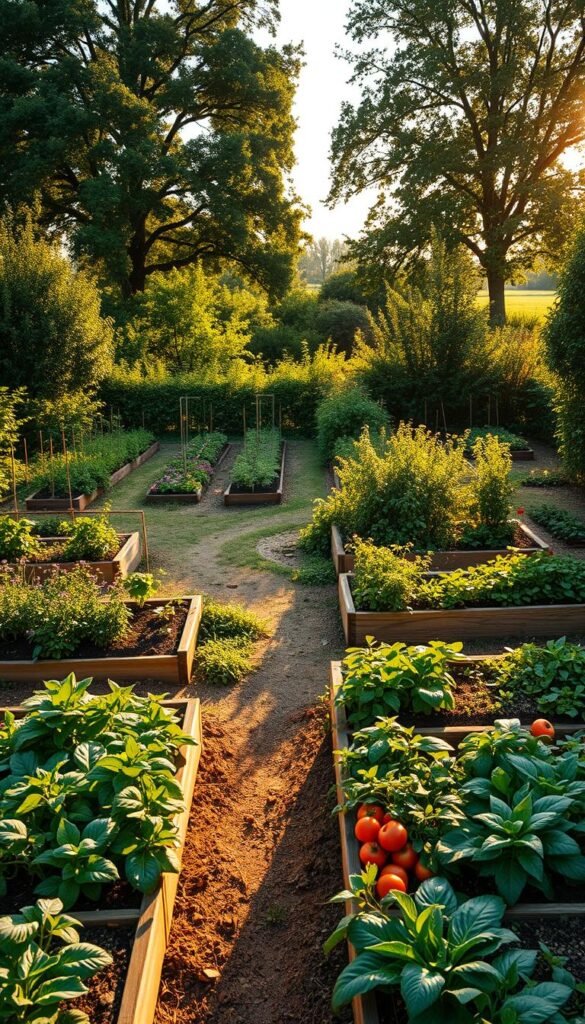
Your journey to fresh, homegrown veggies starts with smart space planning. Whether you’re working with a sprawling backyard or a sunny balcony corner, strategic sizing ensures every inch works harder. Let’s map out your green oasis.
Smart Sizing for Effortless Access
Begin by sketching your available area. A 4×4-foot bed lets you reach all plants without stepping on soil—key for healthy roots. For larger harvests, use multiple smaller boxes instead of wide layouts. This keeps pathways clear for kneeling or moving supplies.
Most gardeners stick to beds under 4 feet wide. Why? You’ll avoid straining to tend middle squares. Need inspiration? Explore proven garden plans that balance productivity and comfort. Leave 2-3 feet between boxes for wheelbarrows or kids playing nearby.
Sunlight matters most. Track how light moves across your space for 6+ hours daily. Sloped yards need leveled beds, while patios thrive with elevated planters. Always position water sources within hose length to simplify care.
Thinking ahead pays off. Maybe add pollinator flowers next year or expand tomato sections. Design pathways wide enough for lawnmowers now to save headaches later. Your future self will thank you!
A Step-by-Step Guide to Square Foot Veggie Garden Layout
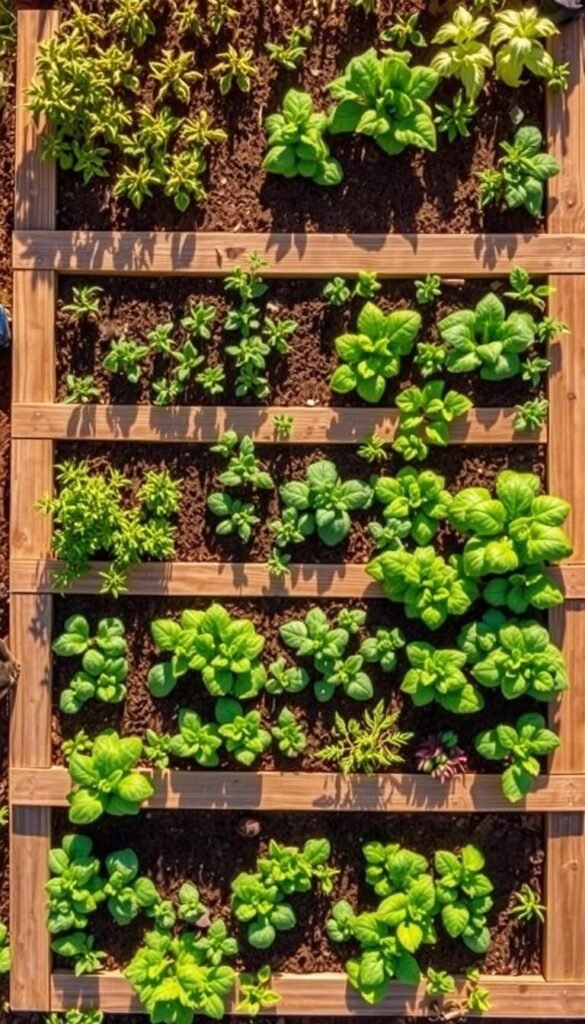
Your growing space becomes a living calendar when you pair smart grid design with seasonal timing. This combination turns small plots into continuous food sources, adapting to your climate and cravings.
Designing Your Grid and Garden Planner
Start by laying your grid directly on the soil surface after filling beds. Repurposed materials work best—try old mini-blind slats connected with waterproof staples or weather-resistant string. These create visible boundaries without blocking plant growth.
Why does this matter? “The grid isn’t just lines—it’s your planting GPS,” explains veteran gardener Mel Bartholomew. Each square becomes a dedicated zone for specific crops, eliminating overcrowding. Use free online planners to drag-and-drop veggie icons into your virtual bed, then print templates for real-world accuracy.
Scheduling Planting Tasks Throughout the Season
Map your year in reverse. Begin with last frost dates, then count backward for seed starting. Cool-weather crops like spinach claim squares early, followed by summer tomatoes. After harvests, replant with fall carrots or kale.
Try this rotation strategy:
- Spring: Lettuce (4 per square)
- Summer: Bush beans (9 per square)
- Fall: Radishes (16 per square)
Track successes in a notebook or app. Note which varieties thrived and where. Next year’s plan will be twice as effective—your personal gardening playbook for nonstop fresh meals.
Building and Preparing Your Garden Beds

The foundation of your thriving green space starts with two critical choices: what holds your plants and what feeds them. Whether you’re a weekend DIYer or prefer ready-made solutions, proper setup ensures seasons of bountiful growth.
Constructing or Choosing Raised Boxes
Wooden frames dominate backyard gardens for good reason. Untreated cedar or redwood lasts 5-7 years, while composite materials offer decade-long durability. Pre-cut kits with interlocking corners simplify assembly—perfect for time-crunched growers.
| DIY Boxes | Pre-Made Boxes |
|---|---|
| $25-$50 materials cost | $80-$200 retail price |
| Customizable sizes | Standard 4×4 designs |
| 2-hour build time | 15-minute setup |
Depth matters most. Shallow 6-inch beds suit herbs and greens, while 12-inch versions handle carrots and potatoes. For small spaces, try stacking planters—they add visual interest while maximizing yield.
Mixing the Optimal Soil Blend
Mel’s Mix remains the gold standard for good reason. Combine equal parts:
- Coarse vermiculite (retains moisture)
- Sphagnum peat moss (acid balance)
- Compost blend (nutrient boost)
This trio creates fluffy, nutrient-rich soil that outperforms regular dirt. One cubic foot fills a 4×4-inch area—use designing the perfect layout plans to calculate quantities. Sustainable swaps like coconut coir work if peat moss isn’t available.
Fill boxes gradually, watering lightly between layers to prevent air pockets. The mix settles 10-15% initially—top it off before planting. You’ll enjoy weed-free growth and minimal compaction for 3-5 years with proper care.
Incorporating Effective Planting Techniques
Elevate your harvests—literally—by thinking beyond ground-level growing. Vertical structures transform vine-heavy crops into space-efficient producers, letting you grow more per square foot without sacrificing precious soil real estate. This approach works wonders in the foot gardening method, where every inch counts.
Smart Vertical Solutions for Climbing Crops
Position trellises along the north side of beds to prevent shading smaller vegetables. Sturdy metal grids or bamboo lattices support heavy producers like cucumbers and winter squash. For delicate peas, use nylon netting they can grip easily.
Train tomato vines early by loosely tying stems to supports with soft cloth strips. This prevents damage as plants mature. Bush varieties often need no staking, perfect for quick rotations.
Try this dynamic duo: plant pole beans at a trellis base with spinach in front. When beans start climbing, spinach gets harvested, freeing space. You’ll squeeze two crops into one square through smart timing.
Prune excess leaves weekly on vertical growers. More airflow means fewer diseases in dense plantings. Focus energy on fruit production by removing suckers below tomato flower clusters.
Choose compact varieties like ‘Sugar Snap’ peas or ‘Spacemaster’ cucumbers for tight spaces. Their natural climbing habit pairs perfectly with vertical systems, yielding bumper crops without chaos.
Selecting and Arranging Your Crops
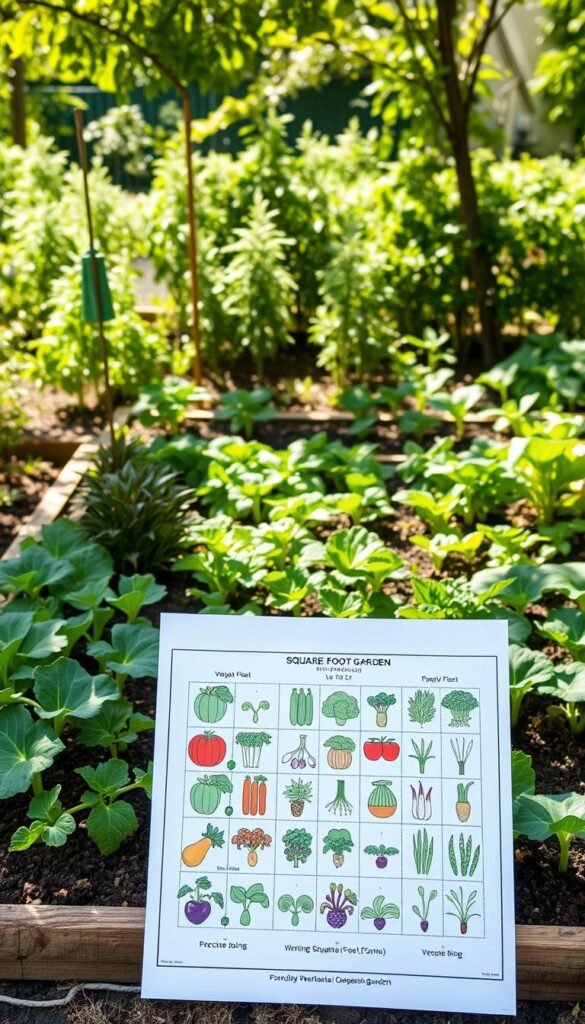
Picture your garden as a living puzzle where every piece nourishes your kitchen. Smart crop placement combines science with your family’s favorite meals, creating edible art that thrives. Let’s turn those squares into a personalized produce section.
Understanding Square Foot Plant Spacing
Think of each square as a studio apartment for your greens. Extra-large residents like tomatoes get their own space, while radishes thrive in cozy groups of 16. Follow this simple rule:
- 1 per square: Broccoli, peppers, basil
- 4 per square: Leaf lettuce, Swiss chard
- 9 per square: Bush beans, spinach
- 16 per square: Carrots, radishes
This system prevents overcrowding while maximizing yield. Always check seed packets for mature sizes—those tiny seedlings can become space hogs!
Practicing Companion Planting for Maximum Yield
Some plants make better neighbors than others. Basil boosts tomato flavor while repelling flies, and marigolds act as natural security guards against pests. Try these power couples:
- Carrots + onions (confuses root maggots)
- Cucumbers + nasturtiums (traps aphids)
- Corn + beans (natural trellis + nitrogen boost)
When choosing the right vegetable varieties, consider both taste and teamwork. Tall crops like corn belong on the north side, while low-growers like thyme edge southern squares. Rotate plant families yearly to keep soil nutrients balanced.
Wrapping Up Your Square Foot Gardening Adventure
Your compact garden can become a powerhouse of fresh produce with smart planning. Those initial hours spent sketching grids and choosing crops pay off when you’re picking armfuls of vegetables every week. Many gardeners report doubling their usual harvests while using a fraction of their yard.
Don’t let the small amount of space fool you—a single 4×4-foot garden bed can grow enough greens for daily salads and herbs for seasoning. The key lies in rotating crops and using vertical supports to boost yield. With the right mix of plants, you’ll enjoy continuous harvests from spring through fall.
Newcomers often marvel at how foot gardening simplifies maintenance. Weeds struggle to compete in densely planted squares, and targeted watering keeps roots happy without waste. If you’re working with limited room, discover clever ways to maximize small while maintaining accessibility.
Remember: success starts with quality soil and strategic layouts. Track what thrives in your garden beds each season, adjusting plant numbers based on results. Before long, you’ll master the art of growing a surprising lot in every square—no farm-sized plot required.

